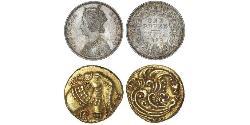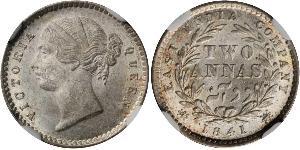1 Rupee (Venduta per $89.0)
1835, British India, East India Company, William IV. Silver Rupee Coin. AU+
Mint Year: 1835 Mint Place: Calcutta Denomination: Rupee (type D/4) Reference: S&W-1.42, KM-450.2. R! Condition: Scattered beg-marks in fields and small scratches, otherwise a nice AU+ Material: Sterling Silver (.925) Diametere: 30mm Weight: 11.66gm
Obverse: Head of King William IV left. Raised initial (F.) on bust truncation. Legend: WILLIAM IIII, KING.
Reverse: Denomination (ONE RUPEE) within wreath. Legend: EAST INDIA COMPANY * 1835. *
The East India Company (also the East India Trading Company, English East India Company, and then the British East India Company) was an early English joint-stock company that was formed initially for pursuing trade with the East Indies, but that ended up trading mainly with the Indian subcontinent and China. The oldest among several similarly formed European East India Companies, the Company was granted an English Royal Charter, under the name Governor and Company of Merchants of London Trading into the East Indies, by Elizabeth I on 31 December 1600. After a rival English company challenged its monopoly in the late 17th century, the two companies were merged in 1708 to form the United Company of Merchants of England Trading to the East Indies, commonly styled the Honourable East India Company, and abbreviated, HEIC; the Company was colloquially referred to as John Company, and in India as Company Bahadur (Hindustani bahadur, "brave").
The East India Company traded mainly in cotton, silk, indigo dye, saltpetre, tea, and opium. However, it also came to rule large swathes of India, exercising military power and assuming administrative functions, to the exclusion, gradually, of its commercial pursuits. Company rule in India, which effectively began in 1757 after the Battle of Plassey, lasted until 1858, when, following the events of the Indian Rebellion of 1857, and under the Government of India Act 1858, the British Crown assumed direct administration of India in the new British Raj. The Company itself was finally dissolved on 1 January 1874, as a result of the East India Stock Dividend Redemption Act.
The Company long held a privileged position in relation to the English, and later the British, government. As a result, it was frequently granted special rights and privileges, including trade monopolies and exemptions. These caused resentment among its competitors, who saw unfair advantage in the Company's position. Despite this resentment, the Company remained a powerful force for over 200 years over India.
William IV (William Henry; 21 August 1765 – 20 June 1837) was King of the United Kingdom of Great Britain and Ireland and of Hanover from 26 June 1830 until his death. William, the third son of George III and younger brother and successor to George IV, was the last king and penultimate monarch of Britain's House of Hanover.
He served in the Royal Navy in his youth and was, both during his reign and afterwards, nicknamed the "Sailor King". He served in North America and the Caribbean, but saw little actual fighting. Since his two older brothers died without leaving legitimate issue, he inherited the throne when he was 64 years old. His reign saw several reforms: the poor law was updated, child labour restricted, slavery abolished in nearly all the British Empire, and the Reform Act 1832 refashioned the British electoral system. Though William did not engage in politics as much as his brother or his father, he was the last monarch to appoint a Prime Minister contrary to the will of Parliament. Through his brother, the Viceroy of Hanover, he granted that kingdom a short-lived liberal constitution.
At his death William had no surviving legitimate children, though he was survived by eight of the ten illegitimate children he had by the actress Dorothea Jordan, with whom he cohabited for 20 years. William was succeeded in the United Kingdom by his niece, Victoria, and in Hanover by his brother, Ernest Augustus I.

spa1 » Incredible India (48 monete)
Indian history has deep roots. The earliest coins from native Indian people I found are belong to Kushan Empire (30–375). You can find couple of them below as well as other ancient India civilizations like Chalukya and Mughal Empires. In 149 ...

|
Postato da:
anonymous 2018-09-24 |
|
||
|
||
|
||
|
||
|
||
1 Gulden Austria Argento
il gruppo ha 7 monete / 6 prezzi
⇑
303 coin descriptions were improved from 2024-04-17 to 2024-04-24
Una di queste è:
1 Real Guatemala (1838 - ) Argento
il gruppo ha 3 monete / 1 prezzi

-600-300-Y2eP8ggtLEYAAAFm568vVgou.jpg)

-300-150-Y2eP8ggtLEYAAAFm568vVgou.jpg)
 Deutsch
Deutsch Русский
Русский Українська
Українська English
English Italiano
Italiano Français
Français Español
Español 汉语
汉语







-300-150-84_BwcI0zyMAAAEq6fJDRaZN.jpg)





